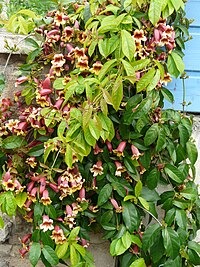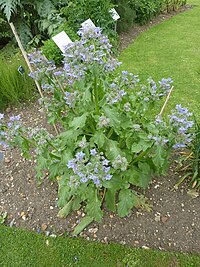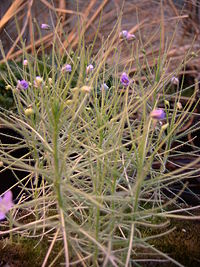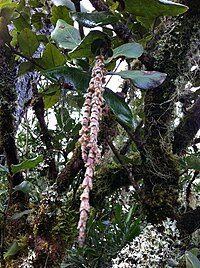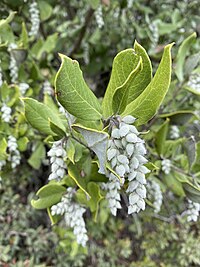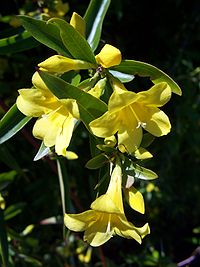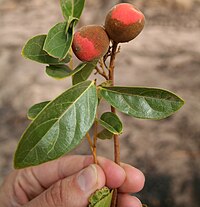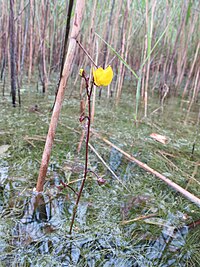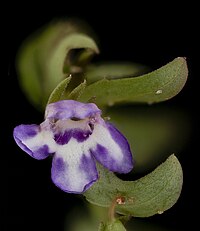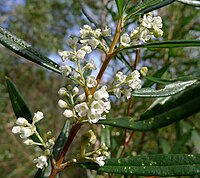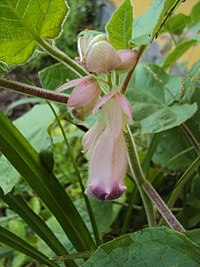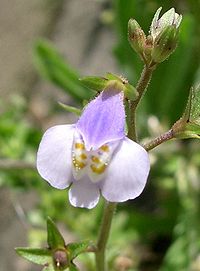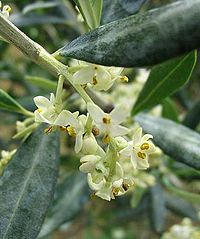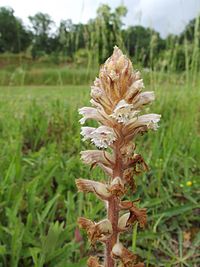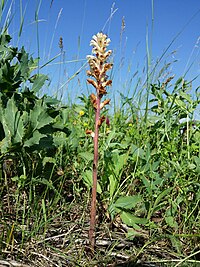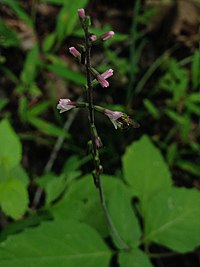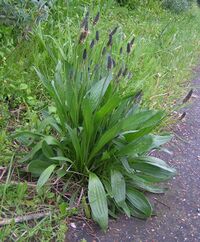Biology:List of lamiid families
The lamiids are a group of about 40 interrelated families of flowering plants.[3][lower-alpha 1] They include about 40,000 species, representing one-seventh of the total diversity of flowering plants, and about half of all asterid species.[5][6] Like most asterids, they tend to have petals that are fused with each other and with the bases of the stamens, and just one integument (covering) around the embryo sac.[7] In lamiids, the fusion of the petals tends to occur late in their development, and the bases of the petals are usually beneath the ovaries.[5]
Of the eight lamiid orders, five have more than one family: Garryales, Gentianales, Icacinales, Lamiales and Solanales. Garryales and Icacinales include trees and shrubs with leaves that usually have stalks but no stipules; in Icacinales, the leaves are arranged spirally. Gentianales species have pitted wood and opposite leaves that are joined across the stem. In Lamiales, plants are mostly herbaceous with opposite leaves, and the five-lobed flowers have approximate mirror-image symmetry. Solanales species usually have sepals that continue to grow with age, even when the plant is fruiting.[8]
Legend
| Family | Type genus and etymology | Total genera; global distribution | Description and uses | Order | Type genus images |
|---|---|---|---|---|---|
| Family and vernacular (common) name | Type genus. Etymology: an associated meaning, derivation or person (a naturalist, unless otherwise noted) | Total genera; global distribution of the species in this family (aside from the polar regions and the dunes of the great deserts) | Description and uses | Order | Type genus images |
Lamiid families
| Family [3][lower-alpha 2][lower-alpha 3] |
Type genus and etymology | Total genera; global distribution | Description and uses[lower-alpha 4] | Order[3] | Type genus images |
|---|---|---|---|---|---|
| Acanthaceae (bear's-breeches family) | Acanthus, from Greek for "thorns"[10][11][12] | 206 genera,[13] mostly tropical, with some species in warm-temperate zones[14] | Annual and perennial shrubs, vines and herbaceous plants, with a few trees and mangroves. Many of the ornamental species have long-lasting flowers. Acanthus leaves are commonly depicted on architectural columns and ornate furniture.[14][15] | Lamiales | |
| Apocynaceae (periwinkle family) | Apocynum, from the Greek name for dogbane or a similar plant[16][17] | 372 genera,[18] distributed throughout the tropics, with a few genera extending into northern and southern temperate zones[19] | A large family with trees, shrubs, mangroves, epiphytes, succulents, and woody and herbaceous vines. Some species have edible fruits or roots, but poisonous seeds. Some have been harvested commercially for timber or to make rubber. Many are ornamentals, including oleander and Vinca (periwinkle).[20][21][22] | Gentianales | |
| Bignoniaceae (trumpetvine family) | Bignonia, for Jean-Paul Bignon (1662–1743), a French statesman and royal librarian[23][24] | 79 genera,[25] distributed widely in the tropics and subtropics, with a few species in temperate zones[26] | Trees, shrubs, vines and perennial herbaceous plants, mostly evergreen. Various species are used in Thai and Laotian cuisine, and to make a drink in Nicaragua. Many species are ornamentals.[23][27] | Lamiales | |
| Boraginaceae (forget-me-not family) | Borago, possibly from Latin for "hairy covering"[28][29][30] | 156 genera,[31] worldwide, with the greatest diversity in Eurasia[32] | Shrubs, trees, vines and herbaceous plants. Borage is cultivated for its oil. Mertensia maritima is an Inuit staple food. Many species are ornamentals.[22][33][34] Alkanna tinctoria has been used as a dye since ancient times.[35] | Boraginales | |
| Byblidaceae (rainbowplant family) | Byblis, for Byblis, a Greek mythological character[36] | 1 genus,[37] in Australia and Papua New Guinea[38] | Shrubby rhizomatous herbaceous plants. These plants have sticky glands on their stalks that trap and kill insects.[39] | Lamiales | |
| Carlemanniaceae (fragrant-princess family) | Carlemannia, for Charles Morgan Lemann (1806–1852)[40][41] | 2 genera,[42] in tropical Southeast Asia[43] | Shrubs and herbaceous perennials with asymmetrical leaves[44] | Lamiales | |
| Convolvulaceae (bindweed family) | Convolvulus, from Latin for "twining"[45][46][47] | 59 genera,[48] worldwide, with more diversity in warm temperate zones and the tropics[49] | Woody and herbaceous vines, shrubs and a few trees. Sweet potatoes are a tropical staple food. Shoots of Ipomoea aquatica are commonly used in Asian cooking. "Morning glory" is a vernacular name for many ornamentals in this family.[15][49] | Solanales | |
| Eucommiaceae (Chinese-rubbertree family) | Eucommia, from Greek for "good gum"[50] | 1 genus,[51] in China[52] | Deciduous trees with spirally arranged leaves. The latex is converted to rubber for insulation and dental fillings.[53][54] | Garryales | |
| Garryaceae (tasselbush family) | Garrya, for Nicholas Garry (c. 1782 – 1856), a merchant and trader[55][56] | 2 genera.[57] Garrya is native to the Americas, and Aucuba is native to East Asia; both are widely cultivated as ornamentals.[55] | Evergreen shrubs and trees with leathery leaves. Aucuba tolerates coal pollution and became a popular garden plant during the Industrial Revolution.[55][58][59] | Garryales | |
| Gelsemiaceae (yellow-jessamine family) | Gelsemium, from an Italian plant name[60][61][62] | 3 genera,[63] in the tropics and subtropics, with a few species extending into North America[64] | Trees, shrubs and woody vines with clear sap. The poisonous yellow jessamine is sometimes grown as an ornamental, especially in the southern United States, and is the state flower of South Carolina.[65][66][67] | Gentianales | |
| Gentianaceae (gentian family) | Gentiana, for Gentius (d. 168 BC), an Illyrian king[68][69] | 103 genera,[70] worldwide[71] | A large family that includes trees, shrubs, vines and other annuals and perennials, some relying on fungi and organic material rather than photosynthesis. Some scented flowers of Fagraea have been used commercially in perfumes, and trees of this genus are harvested for timber in tropical Asia. Gentian root (from Gentiana lutea) is an ingredient in some liqueurs.[22][72][68] | Gentianales | |
| Gesneriaceae (gloxinia family) | Gesneria, for Conrad Gessner (1516–1565)[73][74] | 149 genera,[75] in the tropics worldwide, extending into subtropical and warmer temperate zones[76] | Shrubs, treelets, climbers and herbaceous plants, growing in soil, on rocks or on other plants. Ornamentals include Calceolaria,[lower-alpha 5] florist's gloxinia, African violets and Cape primroses.[22][80] | Lamiales | |
| Hydroleaceae (fiddleleaf family) | Hydrolea, from Greek for "water olive"[81] | 1 genus,[82] scattered worldwide, generally in aquatic or at least moist habitats[83] | Spiny annual and perennial shrubs and herbaceous plants, usually in moist environments. Hydrolea zeylanica shoots are used in Indonesian cooking.[15][84][85] Hydrolea spinosa is an invasive species.[83] | Solanales | |
| Icacinaceae (false-yam family) | Icacina, from an Arawak name[86][87] | 24 genera,[88] throughout the tropics, with one genus (Apodytes) extending into the subtropics[89] | Vines, shrubs and trees. Icacina flour is used in parts of Africa, and Miquelia is used for timber.[59][90][86] | Icacinales | |
| Lamiaceae (mint family) | Lamium, from a Latin plant name, originally from Greek for "wide-open mouth" (on the flowers)[1][2][91] | 232 genera,[92] worldwide[93] | Generally aromatic shrubs and herbaceous plants, with some trees and vines. Many species and genera produce kitchen herbs, including basil, oregano, sage, rosemary, thyme, peppermint and other mints. Mint oil is widely used in the cosmetics and food industries.[15][93] | Lamiales | |
| Lentibulariaceae (bladderwort family) | Utricularia. Lentibularia, an earlier synonym for the genus, is probably from Greek for "lentil-shaped bladders".[94][95][96] | 3 genera,[97] almost worldwide, with the greatest diversity in the tropics[98] | Perennial and annual herbaceous plants, growing in soil, in water and on other plants. All three genera in this family can trap and digest small insects. Pinguicula is used to curdle milk in northern Europe, and occasionally to kill pests in greenhouses.[22][94] | Lamiales | |
| Linderniaceae (wishbone-flower family) | Lindernia, for Franz Balthasar von Lindern (1682–1755), a French physician and botanist[99][100] | 19 genera,[101] in the tropics, except for a few temperate species[102] | Annual and perennial herbaceous plants, with some shrubs. Stems often have four flat sides. Ornamental genera include Torenia and Craterostigma.[59][102] | Lamiales | |
| Loganiaceae (Indian-pink family) | Logania, for James Logan (1674–1751)[103][104] | 16 genera,[105] in the tropics, mostly[106] | Trees, shrubs, woody vines and herbaceous plants with clear sap. Many species in this family contain the pest-control poison strychnine.[59][107][103] | Gentianales | |
| Martyniaceae (unicornplant family) | Martynia, for John Martyn (1699–1768)[108][109] | 5 genera,[110] in the tropical and subtropical Americas[111] | Annuals and perennials, herbaceous with a few shrubs, usually odoriferous. Three of the five genera are covered in sticky hairs that trap and kill insects.[108] | Lamiales | |
| Mazaceae (cupflower family) | Mazus, from Greek for "teat". The lower lip of the flowers is swollen.[112][113][114] | 4 genera,[115] in Tibet, temperate East Asia, and Australasia[116] | Annual and perennial rhizomatous herbaceous plants with stems with four flat sides. Mazus is planted as an ornamental groundcover.[116] | Lamiales | |
| Metteniusaceae (urupagua family) | Metteniusa, for Georg Heinrich Mettenius (1823–1866)[117][118] | 10 genera,[119] throughout the tropics[120] | Evergreen shrubs and trees with spirally arranged leaves. Some of the fruits and nuts are consumed in South America.[59][120][121] | Metteniusales | |
| Montiniaceae (wild-clovebush family) | Montinia, for Lars Jonasson Montin (1723–1785), a Swedish botanist and physician[122][123] | 3 genera,[124] in southern Africa, East Africa and Madagascar[125] | Shrubs and small trees. Crushed leaves of Grevea and Montinia have an acrid taste of pepper and cloves.[27][126][127][125] | Solanales | |
| Oleaceae (olive family) | Olea, from a Latin plant name[128][129][130] | 29 genera,[131] in temperate zones worldwide[132] | Shrubs, trees and woody vines, usually with opposite leaves. Olives have been cultivated around the Mediterranean for food and oil for at least 5000 years. Ash trees are harvested for their strong, flexible timber. Jasmine is used in perfumes and teas. Forsythia and lilacs are sold as cut flowers.[59][133] | Lamiales | |
| Oncothecaceae (kanak-laurel family) | Oncotheca, from Greek for "bulging box" or "bulky anthers"[134][134][135] | 1 genus,[136] in New Caledonia[134] | Evergreen trees and shrubs with leathery leaves[134] | Icacinales | |
| Orobanchaceae (broomrape family) | Orobanche, from Greek and Latin plant names[137][138] | 98 genera,[139] distributed nearly worldwide[140] | Usually parasitic herbaceous plants, occasionally woody or shrubby, and sometimes lacking chlorophyll. Cistanche phelypaea is consumed by the Tuareg in North Africa. Many species are agricultural pests that target beans, sugarcane, sunflowers or other crops.[59][140] | Lamiales | |
| Paulowniaceae (empress-tree family) | Paulownia, for Anna Pavlovna of Russia (1795–1865)[141][142] | 3 genera,[143] scattered in Asia[141] | Evergreen and deciduous trees and viny shrubs. The empress tree is often seen in gardens and parks in North America and Europe.[141] | Lamiales | |
| Pedaliaceae (sesame family) | Pedalium, from Greek for "rudder"[144][145] | 11 genera,[146] mostly in sub-Saharan Africa. Sesame is widely cultivated.[147] | Annual and perennial herbaceous plants, with some deciduous shrubs and trees. Many species have either tubers that store water or succulent trunks. Sesame was being cultivated at least 5500 years ago in Asia, and is today one of the ten most important vegetable oil crops. The seeds are widely used in baking.[27][144] | Lamiales | |
| Phrymaceae (lopseed family) | Phryma, possibly from Greek for "toad"[148][149] | 15 genera,[150] in Africa, the Americas, Asia and Australasia[148] | Rhizomatous herbaceous plants, sometimes aquatic and sometimes slightly woody or shrubby. Mimulus and Leucocarpus have ornamental species.[148] | Lamiales | |
| Plantaginaceae (speedwell family) | Plantago, from a Latin plant name[151][152][153] | 107 genera,[154] worldwide[155] | Vines, shrubs, small trees and other herbaceous plants, growing in soil, in water and on other plants. Ornamentals include foxglove and snapdragon. Foxglove is also a source of digitalin, a heart stimulant. Psyllium is used medically to lower cholesterol and treat constipation.[59][156] | Lamiales | |
| Plocospermataceae (staghorn-shrub family) | Plocosperma, from Greek for "tufted seeds"[157] | 1 genus,[158] in dry forests and scrubland in Mexico and Central America[159] | One species of shrubs and small trees[59][157] | Lamiales | |
| Rubiaceae (coffee family) | Rubia, from Latin for "red". The roots have provided a red dye going back millennia.[160][161][162] | 609 genera,[163] worldwide[164] | A large family of annuals and perennials, including vines, shrubs, trees and epiphytes. Coffee (Coffea) is the second most traded world commodity, after fossil fuels. Cinchona (the source of quinine) is still used as an antimalarial. Other plants produce edible fruits, natural dyes and timber.[15][164] | Gentianales | |
| Schlegeliaceae (higuerito family) | Schlegelia, for Hermann Schlegel (1804–1884)[165][166] | 4 genera,[167] in the tropics of the Americas[168] | Evergreens, including vines, shrubs and trees with pale bark[168] | Lamiales | |
| Scrophulariaceae (figwort family) | Scrophularia, from Latin for "scrofula", which it supposedly cured[169][170] | 60 genera,[171] almost worldwide[172] | Herbaceous plants, deciduous and evergreen shrubs, and occasionally trees and vines. Ornamental genera include Eremophila, Scrophularia and Verbascum.[22][173] | Lamiales | |
| Solanaceae (nightshade family) | Solanum, from a Latin plant name[174][175][176] | 98 genera,[177] worldwide, especially in the Americas[178] | Annual and perennial shrubs, trees, climbers and herbaceous plants, including a few epiphytes. Potatoes were first bred and cultivated around 8000 years ago and chili peppers around 6000 years ago in the Americas. Both were introduced around the world in the 1500s. Tomatoes, regarded by the Aztecs as weeds, became a staple food when introduced in Europe.[22][179][180] | Solanales | |
| Sphenocleaceae (gooseweed family) | Sphenoclea, from Greek for "closed wedge" (on the fruit capsules)[181] | 1 genus,[182] scattered in the tropics and subtropics[183] | Herbaceous succulent annuals. Gooseweed is a frequent weed in rice paddies,[27][184][181] but the roots produce a compound that is effective against a common rice nematode.[185] | Solanales | |
| Stilbaceae (candlesticks family) | Stilbe, from Greek for "shining"[186][187] | 11 genera,[188] in the Western Cape of South Africa, except for the tropical genus Nuxia[189] | Evergreen shrubs, trees and perennial herbaceous plants. Nuxia verticillata bark is sometimes added to alcoholic drinks.[186] | Lamiales | |
| Tetrachondraceae (rustweed family) | Tetrachondra, from Greek for "four-cartilaged"[190][191] | 2 genera,[192] in the Americas and New Zealand[193] | Herbaceous aquatic and marshy perennials with prostrate succulent stems[190] | Lamiales | |
| Thomandersiaceae (West-African-bitterbush family) | Thomandersia, for Thomas Anderson (1832–1870)[194] | 1 genus,[195] in Central and western Africa[196] | Shrubs, small trees and a few vines, all evergreen. The leaves have antiparasitic properties.[196] | Lamiales | |
| Vahliaceae (flindersbush family) | Vahlia, for Martin Vahl (1749–1804)[197] | 1 genus,[198] in the Asian and African tropics[199] | Herbaceous annuals and biennials, sometimes glandular, with stalkless leaves[15][200][201] | Vahliales | |
| Verbenaceae (vervain family) | Verbena, a term from Latin for any plants used in some religious ceremonial processions[202][203][204] | 31 genera,[205] mainly in the Americas[206] | Evergreen and deciduous shrubs, trees, vines and herbaceous plants, often aromatic. Some lemony Aloysia species are used in perfumes, alcoholic drinks and potpourris. Some Lippia species are used as kitchen herbs.[22][207] | Lamiales |
See also
- Glossary of botanical terms
- List of plant family names with etymologies
- List of basal asterid families
Notes
- ↑ The lamiids form a clade, that is, a group of plants more closely related to each other than they are to plants outside the group.[4]
- ↑ Each family's formal name ends in the Latin suffix -aceae and is derived from the name of a genus that is or once was part of the family.[9]
- ↑ The vernacular names immediately follow the family names in the cited source.
- ↑ For everything cited here from Plants of the World Online (POWO), see their license. Some of POWO's data originally appeared in different databases. After reaching the page for each family, these databases (if any) will appear under the "General information" tab. The databases all focus on description rather than uses.
- ↑ Many taxonomists prefer to place Calceolaria and Jovellana into a separate family, called Calceolariaceae.[77][78][79]
Citations
Template:Featured list is only for Wikipedia:Featured lists.
- ↑ 1.0 1.1 Christenhusz, Fay & Chase 2017, p. 578.
- ↑ 2.0 2.1 Stearn 2002, p. 184.
- ↑ 3.0 3.1 3.2 Christenhusz, Fay & Chase 2017, pp. 511–584.
- ↑ Christenhusz, Fay & Chase 2017, p. 642.
- ↑ 5.0 5.1 Stull et al. 2015, p. 1794.
- ↑ Bremer, Friis & Bremer 2004, p. 496.
- ↑ Stevens 2022, asterids.
- ↑ Christenhusz, Fay & Chase 2017, pp. 511,514,516,534,543.
- ↑ ICN, art. 18.
- ↑ Stearn 2002, p. 29.
- ↑ Coombes 2012, p. 26.
- ↑ IPNI, Acanthaceae, Type.
- ↑ POWO, Acanthaceae.
- ↑ 14.0 14.1 Christenhusz, Fay & Chase 2017, pp. 563–566.
- ↑ 15.0 15.1 15.2 15.3 15.4 15.5 POWO, Flora of Tropical East Africa.
- ↑ IPNI, Apocynaceae, Type.
- ↑ Christenhusz, Fay & Chase 2017, pp. 528–529.
- ↑ POWO, Apocynaceae.
- ↑ Kadereit & Bittrich 2019, p. 232.
- ↑ Kadereit & Bittrich 2019, p. 207.
- ↑ Christenhusz, Fay & Chase 2017, pp. 525–529.
- ↑ 22.0 22.1 22.2 22.3 22.4 22.5 22.6 22.7 POWO, Flora of West Tropical Africa.
- ↑ 23.0 23.1 Christenhusz, Fay & Chase 2017, pp. 566–568.
- ↑ IPNI, Bignoniaceae, Type.
- ↑ POWO, Bignoniaceae.
- ↑ Kadereit 2004, p. 12.
- ↑ 27.0 27.1 27.2 27.3 POWO, Flora of Zambesiaca.
- ↑ Stearn 2002, p. 68.
- ↑ Coombes 2012, p. 69.
- ↑ IPNI, Boraginaceae, Type.
- ↑ POWO, Boraginaceae.
- ↑ Kadereit & Bittrich 2016, p. 60.
- ↑ Kadereit & Bittrich 2016, p. 41.
- ↑ Christenhusz, Fay & Chase 2017, pp. 529–532.
- ↑ Kadereit & Bittrich 2016, p. 61.
- ↑ Burkhardt 2018, p. B-122.
- ↑ POWO, Byblidaceae.
- ↑ Kadereit 2004, p. 48.
- ↑ Christenhusz, Fay & Chase 2017, pp. 558–559.
- ↑ Burkhardt 2018, p. C-12.
- ↑ USDA, Carlemanniaceae, Type.
- ↑ POWO, Carlemanniaceae.
- ↑ Kadereit 2004, p. 58.
- ↑ Christenhusz, Fay & Chase 2017, pp. 544–545.
- ↑ Stearn 2002, p. 103.
- ↑ Coombes 2012, p. 102.
- ↑ IPNI, Convolvulaceae, Type.
- ↑ POWO, Convolvulaceae.
- ↑ 49.0 49.1 Christenhusz, Fay & Chase 2017, pp. 534–535.
- ↑ Stearn 2002, p. 136.
- ↑ POWO, Eucommiaceae.
- ↑ Kadereit & Bittrich 2016, p. 195.
- ↑ Kadereit & Bittrich 2016, p. 193.
- ↑ Christenhusz, Fay & Chase 2017, p. 514.
- ↑ 55.0 55.1 55.2 Christenhusz, Fay & Chase 2017, p. 515.
- ↑ IPNI, Garryaceae, Type.
- ↑ POWO, Garryaceae.
- ↑ Kadereit & Bittrich 2016, p. 197.
- ↑ 59.0 59.1 59.2 59.3 59.4 59.5 59.6 59.7 59.8 POWO, Neotropikey.
- ↑ Stearn 2002, p. 149.
- ↑ Coombes 2012, p. 152.
- ↑ IPNI, Gelsemiaceae, Type.
- ↑ POWO, Gelsemiaceae.
- ↑ Kadereit & Bittrich 2019, p. 449.
- ↑ Kadereit & Bittrich 2019, p. 447.
- ↑ Christenhusz, Fay & Chase 2017, p. 524.
- ↑ Kadereit & Bittrich 2019, p. 450.
- ↑ 68.0 68.1 Christenhusz, Fay & Chase 2017, pp. 520–522.
- ↑ IPNI, Gentianaceae, Type.
- ↑ POWO, Gentianaceae.
- ↑ Kadereit & Bittrich 2019, p. 464.
- ↑ Kadereit & Bittrich 2019, p. 453.
- ↑ Stearn 2002, p. 150.
- ↑ IPNI, Gesneriaceae, Type.
- ↑ POWO, Gesneriaceae.
- ↑ Kadereit 2004, p. 92.
- ↑ Angiosperm Phylogeny Group 2016.
- ↑ POWO, Calceolariaceae.
- ↑ USDA, Calceolariaceae, Type.
- ↑ Christenhusz, Fay & Chase 2017, pp. 548–551.
- ↑ Stearn 2002, p. 170.
- ↑ POWO, Hydroleaceae.
- ↑ 83.0 83.1 Kadereit & Bittrich 2016, p. 220.
- ↑ Kadereit & Bittrich 2016, p. 217.
- ↑ Christenhusz, Fay & Chase 2017, pp. 542–543.
- ↑ 86.0 86.1 Christenhusz, Fay & Chase 2017, pp. 512–513.
- ↑ IPNI, Icacinaceae, Type.
- ↑ POWO, Icacinaceae.
- ↑ Kadereit & Bittrich 2016, p. 243.
- ↑ Kadereit & Bittrich 2016, p. 239.
- ↑ IPNI, Lamiaceae, Type.
- ↑ POWO, Lamiaceae.
- ↑ 93.0 93.1 Christenhusz, Fay & Chase 2017, pp. 573–578.
- ↑ 94.0 94.1 Christenhusz, Fay & Chase 2017, pp. 569–570.
- ↑ USDA, Lentibulariaceae, Type.
- ↑ POWO, Lentibularia.
- ↑ POWO, Lentibulariaceae.
- ↑ Kadereit 2004, p. 279.
- ↑ Burkhardt 2018, p. L-44.
- ↑ USDA, Linderniaceae, Type.
- ↑ POWO, Linderniaceae.
- ↑ 102.0 102.1 Christenhusz, Fay & Chase 2017, pp. 557–558.
- ↑ 103.0 103.1 Christenhusz, Fay & Chase 2017, pp. 522–524.
- ↑ IPNI, Loganiaceae, Type.
- ↑ POWO, Loganiaceae.
- ↑ Kadereit & Bittrich 2019, p. 517.
- ↑ Kadereit & Bittrich 2019, p. 511.
- ↑ 108.0 108.1 Christenhusz, Fay & Chase 2017, p. 560.
- ↑ IPNI, Martyniaceae, Type.
- ↑ POWO, Martyniaceae.
- ↑ Kadereit 2004, p. 287.
- ↑ Stearn 2002, p. 203.
- ↑ Coombes 2012, p. 205.
- ↑ USDA, Mazaceae, Type.
- ↑ POWO, Mazaceae.
- ↑ 116.0 116.1 Christenhusz, Fay & Chase 2017, p. 579.
- ↑ Burkhardt 2018, p. M-47.
- ↑ USDA, Metteniusaceae, Type.
- ↑ POWO, Metteniusaceae.
- ↑ 120.0 120.1 Christenhusz, Fay & Chase 2017, pp. 513–514.
- ↑ Kadereit & Bittrich 2016, p. 263.
- ↑ Burkhardt 2018, p. M-68.
- ↑ IPNI, Montiniaceae, Type.
- ↑ POWO, Montiniaceae.
- ↑ 125.0 125.1 Kadereit & Bittrich 2016, p. 271.
- ↑ Kadereit & Bittrich 2016, p. 269.
- ↑ Christenhusz, Fay & Chase 2017, pp. 541–542.
- ↑ Stearn 2002, p. 223.
- ↑ Coombes 2012, p. 217.
- ↑ IPNI, Oleaceae, Type.
- ↑ POWO, Oleaceae.
- ↑ Kadereit 2004, p. 299.
- ↑ Christenhusz, Fay & Chase 2017, pp. 545–547.
- ↑ 134.0 134.1 134.2 134.3 Christenhusz, Fay & Chase 2017, p. 511.
- ↑ Quattrocchi 2019, p. 1876.
- ↑ POWO, Oncothecaceae.
- ↑ Stearn 2002, p. 226.
- ↑ IPNI, Orobanchaceae, Type.
- ↑ POWO, Orobanchaceae.
- ↑ 140.0 140.1 Christenhusz, Fay & Chase 2017, pp. 582–584.
- ↑ 141.0 141.1 141.2 Christenhusz, Fay & Chase 2017, p. 581.
- ↑ USDA, Paulowniaceae, Type.
- ↑ POWO, Paulowniaceae.
- ↑ 144.0 144.1 Christenhusz, Fay & Chase 2017, pp. 562–563.
- ↑ IPNI, Pedaliaceae, Type.
- ↑ POWO, Pedaliaceae.
- ↑ Kadereit 2004, p. 316.
- ↑ 148.0 148.1 148.2 Christenhusz, Fay & Chase 2017, pp. 579–580.
- ↑ IPNI, Phrymaceae, Type.
- ↑ POWO, Phrymaceae.
- ↑ Stearn 2002, p. 242.
- ↑ Coombes 2012, p. 237.
- ↑ IPNI, Plantaginaceae, Type.
- ↑ POWO, Plantaginaceae.
- ↑ Kadereit 2004, p. 328.
- ↑ Christenhusz, Fay & Chase 2017, pp. 551–555.
- ↑ 157.0 157.1 Christenhusz, Fay & Chase 2017, p. 544.
- ↑ POWO, Plocospermataceae.
- ↑ Kadereit 2004, p. 331.
- ↑ Christenhusz, Fay & Chase 2017, p. 520.
- ↑ Stearn 2002, p. 262.
- ↑ IPNI, Rubiaceae, Type.
- ↑ POWO, Rubiaceae.
- ↑ 164.0 164.1 Christenhusz, Fay & Chase 2017, pp. 516–520.
- ↑ Burkhardt 2018, p. S-28.
- ↑ USDA, Schlegeliaceae, Type.
- ↑ POWO, Schlegeliaceae.
- ↑ 168.0 168.1 Christenhusz, Fay & Chase 2017, pp. 570–571.
- ↑ Stearn 2002, p. 271.
- ↑ IPNI, Scrophulariaceae, Type.
- ↑ POWO, Scrophulariaceae.
- ↑ Kadereit 2004, p. 345.
- ↑ Christenhusz, Fay & Chase 2017, pp. 555–557.
- ↑ Stearn 2002, p. 279.
- ↑ Coombes 2012, p. 276.
- ↑ IPNI, Solanaceae, Type.
- ↑ POWO, Solanaceae.
- ↑ Kadereit & Bittrich 2016, p. 312.
- ↑ Kadereit & Bittrich 2016, p. 295.
- ↑ Christenhusz, Fay & Chase 2017, pp. 536–541.
- ↑ 181.0 181.1 Christenhusz, Fay & Chase 2017, p. 542.
- ↑ POWO, Sphenocleaceae.
- ↑ Kadereit & Bittrich 2016, p. 360.
- ↑ Kadereit & Bittrich 2016, p. 359.
- ↑ Kadereit & Bittrich 2016, p. 361.
- ↑ 186.0 186.1 Christenhusz, Fay & Chase 2017, pp. 559–560.
- ↑ IPNI, Stilbaceae, Type.
- ↑ POWO, Stilbaceae.
- ↑ Kadereit 2004, p. 437.
- ↑ 190.0 190.1 Christenhusz, Fay & Chase 2017, pp. 547–548.
- ↑ IPNI, Tetrachondraceae, Type.
- ↑ POWO, Tetrachondraceae.
- ↑ Kadereit 2004, p. 443.
- ↑ Burkhardt 2018, p. T-15.
- ↑ POWO, Thomandersiaceae.
- ↑ 196.0 196.1 Christenhusz, Fay & Chase 2017, p. 571.
- ↑ Burkhardt 2018, p. V-1.
- ↑ POWO, Vahliaceae.
- ↑ Kadereit & Bittrich 2016, p. 382.
- ↑ Kadereit & Bittrich 2016, p. 381.
- ↑ Christenhusz, Fay & Chase 2017, p. 533.
- ↑ Stearn 2002, p. 306.
- ↑ Coombes 2012, p. 299.
- ↑ IPNI, Verbenaceae, Type.
- ↑ POWO, Verbenaceae.
- ↑ Kadereit 2004, p. 458.
- ↑ Christenhusz, Fay & Chase 2017, pp. 572–573.
References
- Angiosperm Phylogeny Group (2016). "An update of the Angiosperm Phylogeny Group classification for the orders and families of flowering plants: APG IV". Botanical Journal of the Linnean Society 181 (1): 1–20. doi:10.1111/boj.12385.
- Bremer, Kåre; Friis, Elsemarie; Bremer, Birgitta (June 1, 2004). "Molecular Phylogenetic Dating of Asterid Flowering Plants Shows Early Cretaceous Diversification". Systematic Biology 53 (3): 496–505. doi:10.1080/10635150490445913. PMID 15503676. https://academic.oup.com/sysbio/article/53/3/496/2842933#:~:text=Asterids%20comprise%20more%20than%2080%2C000,3%20of%20all%20flowering%20plants.. Retrieved January 3, 2023.
- Burkhardt, Lotte (2018) (in German) (pdf). Verzeichnis eponymischer Pflanzennamen – Erweiterte Edition. Berlin: Botanic Garden and Botanical Museum, Freie Universität Berlin. doi:10.3372/epolist2018. ISBN 978-3-946292-26-5. https://doi.org/10.3372/epolist2018. Retrieved January 1, 2021. See http://creativecommons.org/licenses/by/4.0/ for license.
- Christenhusz, Maarten; Fay, Michael Francis; Chase, Mark Wayne (2017). Plants of the World: An Illustrated Encyclopedia of Vascular Plants. Chicago, Illinois: Kew Publishing and The University of Chicago Press. pp. 18–637. ISBN 978-0-226-52292-0.
- Coombes, Allen (2012). The A to Z of Plant Names: A Quick Reference Guide to 4000 Garden Plants. Portland, Oregon: Timber Press. ISBN 978-1-60469-196-2.
- IPNI (2022). "International Plant Names Index". London, Boston and Canberra: Royal Botanic Gardens, Kew; Harvard University Herbaria & Libraries; and the Australian National Botanic Gardens. https://www.ipni.org.
- Kadereit, Joachim W., ed (2004). Lamiales (except Acanthaceae including Avicenniaceae). The Families and Genera of Vascular Plants. VII. ISBN 978-3-540-40593-1. https://books.google.com/books?id=kcSZriBQGp4C.
- Kadereit; Bittrich, Volker, eds (2016). Flowering Plants. Eudicots: Aquifoliales, Boraginales, Bruniales, Dipsacales, Escalloniales, Garryales, Paracryphiales, Solanales (except Convolvulaceae), Icacinaceae, Metteniusaceae, Vahliaceae. The Families and Genera of Vascular Plants. XIV. ISBN 978-3-319-28534-4. https://books.google.com/books?id=0tr7CwAAQBAJ.
- Kadereit, Joachim W.; Bittrich, Volker (2019). Flowering Plants. Eudicots - Apiales, Gentianales (except Rubiaceae). The Families and Genera of Vascular Plants. XV. ISBN 978-3-319-93604-8. https://doi.org/10.1007/978-3-319-93605-5_8.
- POWO (2019). "Plants of the World Online". London: Royal Botanic Gardens, Kew. http://www.plantsoftheworldonline.org/. See their terms-of-use license.
- Quattrocchi, Umberto (2019). CRC World Dictionary of Plant Names, Volume III, M–Q. Boca Raton, Florida: CRC Press. ISBN 978-0-367-44751-9.
- Stearn, William (2002). Stearn's Dictionary of Plant Names for Gardeners. London: Cassell. ISBN 978-0-304-36469-5.
- Stevens, P.F. (2022). "Angiosperm Phylogeny Website". Missouri Botanical Garden. http://www.mobot.org/mobot/research/APWeb/.
- Stull, Gregory W.; Duno de Stefano, Rodrigo; Soltis, Douglas E.; Soltis, Pamela S. (November 2015). "Resolving basal lamiid phylogeny and the circumscription of Icacinaceae with a plastome-scale data set". American Journal of Botany 102 (11): 1794–1813. doi:10.3732/ajb.1500298. PMID 26507112. https://www.researchgate.net/publication/283306676.
- Turland, N. J., ed. International Code of Nomenclature for algae, fungi, and plants (Shenzhen Code) adopted by the Nineteenth International Botanical Congress Shenzhen, China, July 2017 (electronic ed.). Glashütten: International Association for Plant Taxonomy. https://www.iapt-taxon.org/nomen/pages/main/art_18.html. Retrieved February 25, 2022.
- "USDA, Agricultural Research Service, National Plant Germplasm System". Beltsville, Maryland: National Germplasm Resources Laboratory. 2022. https://npgsweb.ars-grin.gov/gringlobal/taxon/taxonomysearch?t=family.






